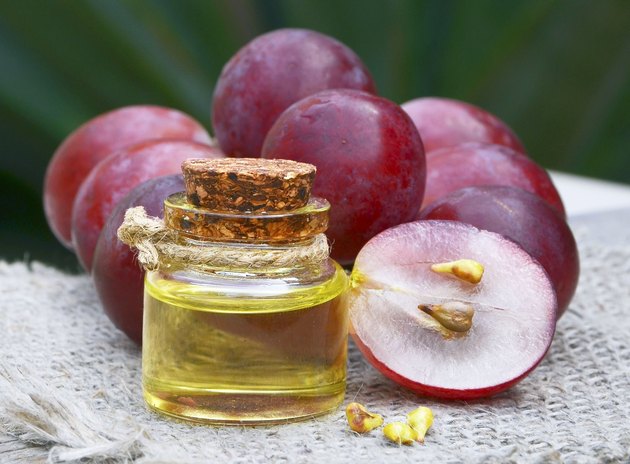How Do Olive Oil and Grape Seed Oil Stack Up?
Olive oil is extracted from olives, while grapeseed oil is a byproduct of the winemaking industry. Both are suitable as cooking oils for use in many of the same dishes, but there are some distinct differences in taste. Although the fat composition differs slightly, grapeseed oil and olive oil are nutritionally similar, so whichever you choose may offer health benefits.

Calories and Fat Content
Both olive oil and grapeseed oil contain approximately 120 calories per tablespoon, according to the USDA National Nutrient Database. Grapeseed oil compared to olive oil is equal in its fat content — 13.6 grams per tablespoon, which is 21 percent of the daily value (DV). The saturated fat content is similar, with olive oil and grapeseed oil containing 1.9 grams and 1.3 grams per tablespoon, respectively.
Olive Oil: More Monounsaturated Fat
The total fat content of olive oil is primarily healthy monounsaturated fat. Monounsaturated and polyunsaturated fat help with the absorption of vitamins and with the production of vitamin E, says the FDA. They also insulate and cushion your body and support metabolism. The monounsaturated fat content of olive oil is 9.85 grams per tablespoon compared to 2.19 grams in grapeseed oil.
Grapeseed Oil: More Polyunsaturated Fats
Grapeseed oil is mostly comprised of polyunsaturated fatty acids with 9.5 grams; olive oil contains 1.42 grams per tablespoon. Polyunsaturated fats are considered essential because they’re required for normal body functioning. However, since they are not made by your body, you must get them through your diet. Essential fats play a role in many body processes, including immune and nervous system function, blood clotting and blood pressure regulation, says the FDA.
Omega-3 and Omega-6 Fatty Acids
The omega-3 and omega-6 fatty acids are essential polyunsaturated fats. The omega-6 acids are readily available in the American diet, but sources of omega-3 acids are more limited. These two fatty acids need to be balanced in equal amounts to work together effectively. A study published in 2016 in the journal Nutrients, found that the ratio of omega-3 to omega-6 plays an important role in health and the prevention and management of obesity.
Grapeseed oil is richer in omega-6 fatty acids with 9.46 grams compared to olive oil’s 1.31 grams in a tablespoon. However, olive oil has the most omega-3 fatty acid, which you might need the more of to balance the omega-6 acids in your body. Olive oil contains 103 milligrams of omega-3, which is 6 percent DV in 1 tablespoon; grapeseed oil has 14 milligrams or 1 percent DV.
Other Beneficial Nutrients
Because olive oil and grapeseed oil are plant-derived, neither contains cholesterol. Both oils provide vitamin E, which helps boost your immune system and protects against cell damage. Each tablespoon of grapeseed oil contains 3.9 milligrams of vitamin E — 26 percent of the daily requirement for adults — which is twice the amount of the vitamin E in olive oil.
Olive oil has 8.1 micrograms of vitamin K — a nutrient important for blood clotting — in each tablespoon, but grapeseed oil has none. The adequate intake of vitamin K is 90 micrograms for adult women and 120 micrograms for adult males, according to the National Institutes of Health.
Read More: Is Grapeseed Oil Healthy?
Flavor Differences
The aroma and flavor of each oil are distinctly different. With its mild, light taste, grapeseed oil is a good choice for cooking, especially when used with subtly flavored foods. Grapeseed oil also works best as a base for salad dressings or baking. Olive oil has a fruity taste which can vary widely depending on the type of olives used and how the oil is processed. Unrefined virgin oil, for example, tends to have stronger taste and aroma. This distinct flavor makes olive oil a great dipping oil for bread.
For use in frying, grapeseed oil and olive oil have similar smoke points. However, according to a study by the Olive Wellness Institute, Australian researchers found that the smoke point is a poor indicator of stability in oil when heated. The more refined the oil is, the less suitable it is for high-temperature cooking. Virgin and extra virgin oil performed the best for heat stability. It’s not recommended to substitute grapeseed oil for extra virgin olive oil, as it is less stable and not as safe to use for frying.
Discover more from ReviewFitHealth.com
Subscribe to get the latest posts sent to your email.